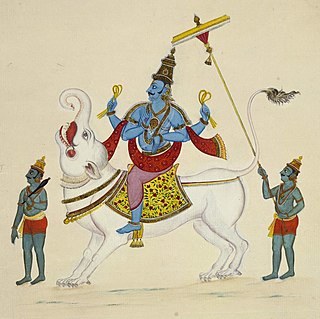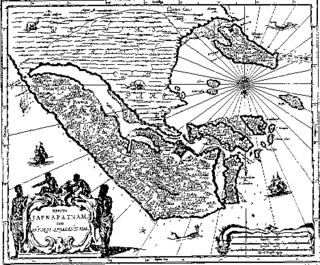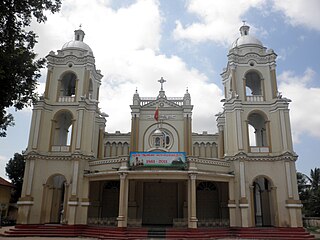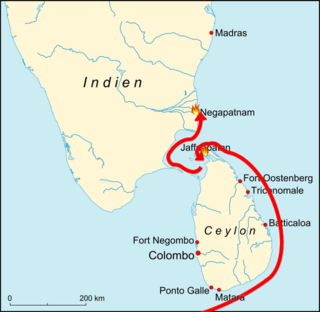Related Research Articles

Varuna is a Hindu god, associated with the sky, oceans, and water. In the Vedic scriptures, he is paired with the god Mitra and is the lord of Ṛta (justice) and Satya (truth). Varuna is also mentioned as an Aditya, the sons of the goddess Aditi.

The Jaffna kingdom, also known as Kingdom of Aryachakravarti, was a historical kingdom of what today is northern Sri Lanka. It came into existence around the town of Jaffna on the Jaffna peninsula and was traditionally thought to have been established after the invasion of Kalinga Magha from Kalinga in India. Established as a powerful force in the north, northeast and west of the island, it eventually became a tribute-paying feudatory of the Pandyan Empire in modern South India in 1258, gaining independence when the last Pandyan ruler of Madurai was defeated and expelled in 1323 by Malik Kafur, the army general of the Delhi Sultanate. For a brief period in the early to mid-14th century it was an ascendant power in the island of Sri Lanka, to which all regional kingdoms accepted subordination. However, the kingdom was overpowered by the rival Kotte kingdom around 1450 when it was invaded by Prince Sapumal under the orders of Parakramabahu VI.

The Thanjavur Nayakdynasty were the rulers of Thanjavur in the 15th and 17th centuries. The Nayaks, who belonged to the Telugu-speaking Balija social group were originally appointed as provincial governors by the Vijayanagara Emperor in the 15th century, who divided the territory into Nayak kingdoms which were Madurai, Tanjore, Gingee and Kalahasthi. In the mid-15th century they became an independent kingdom, although they continued their alliance with the Vijayanagara Empire. The Thanjavur Nayaks were notable for their patronage of literature and the arts.
Karaiyar is a Sri Lankan Tamil caste found mainly on the northern and eastern coastal areas of Sri Lanka, and globally among the Tamil diaspora.
Kayts, is one of the important small island off the coast of the Jaffna Peninsula in northern Sri Lanka. There are a number of other villages within the Kayts Island such as Allaippiddi, Mankumpan, Velanai, Saravanai, Puliyankoodal, Suruvil, Naranthanai, Karampon and Melinchimunai.
The following is a chronological overview of the history of the Karavas and Karaiyars caste of Sri Lanka and India. Both communities were historically also known as Kurukulam, meaning Kuru clan.
Rama Deva Raya ascended the throne after a gruesome war in 1617 as the Emperor of Vijaynagara. In 1614 his father, Sriranga II the preceding emperor and his family were murdered by rival factions headed by Jagga Raya, who was one of their kins. Rama Deva himself was smuggled out of the prison by Yachama Naidu, a faithful commander and the viceroy of earlier emperor Venkata II.

Cankili II, also spelled Sangili) was the last king of the Jaffna kingdom and was a usurper who came to throne with a palace massacre of the royal prince and the regent Arasa-kesari in 1617. His regency was rejected by the Portuguese colonials in Colombo, Sri Lanka. His reign was secured with military forces from the Thanjavur Nayaks and Karaiyar captains. He was defeated by the Portuguese in 1619 and was taken to Goa and beheaded. With his death the Aryacakravarti line of Kings who had ruled the kingdom for over 300 years came to an end.
Periyapillai was of one of the Aryacakravarti rulers of Jaffna kingdom who followed in the chaotic period after the death of Cankili I(1519–1561). Some sources claim that he deposed the Cankili I's son, Puviraja Pandaram as soon as Cankili I died. Others say that there was an intermediate ruler named Kasi Nainar between him and the death of Cankili I. He with the help of Thanjavur Nayak help mounted an attack on the Portuguese fort in the Mannar Island to regain territory lost during Cankili's rule but he was defeated. Due to a local uprising he lost power to Puviraja Pandaram. He is considered to be the father of the last king of the Kingdom, Cankili II and Migapulle Arachchi.
Migapulle Arachchi was a feudal lord from the Jaffna Kingdom who became a rebel leader just after its annexation by the Portuguese Empire in 1619. His title Arachchi, is a title given to the commanders of Lascarins or native military forces.

The Portuguese conquest of the Jaffna kingdom occurred after Portuguese traders arrived at the rival Kotte kingdom in the southwest of modern Sri Lanka in 1505. Many kings of Jaffna, such as Cankili I, initially confronted the Portuguese in their attempts at converting the locals to Roman Catholicism, but eventually made peace with them.
When to date the start of the history of the Jaffna kingdom is debated among historians.
Achuthappa Nayak was the Nayaka of Thanjavur under the Vijayanagara Empire from 1560 to 1614. From 1560 to 1580, he was co-Nayaka along with his father and from 1580 to 1614, he ruled on his own. His reign was eventful and its later years were marked by conflict.
Raghunatha Nayak was the most powerful king of the Thanjavur Nayak Dynasty. He was the third ruler of Thanjavur, southern India, from the Nayak dynasty. He belongs to Balija caste. He ruled from 1600 to 1634 and is noted for the attainments of Thanjavur in literature, art, and Carnatic music.

The statue of Our Lady of Miracles, Jaffna Patão, is a wooden sculpture now preserved in the Church of São Pedro in Bainguinim, Goa, India.

Sinhalese–Portuguese conflicts refers to the series of armed engagements that took place from 1518 AD to 1658 AD in Sri Lanka between the native Sinhalese and Tamil kingdoms and the Portuguese Empire. It spanned from the Transitional to the Kandyan periods of Sri Lankan history. A combination of political and military moves gained the Portuguese control over most of the island, but their invasion of the final independent kingdom was a disaster, leading to a stalemate in the wider war and a truce from 1621. In 1638 the war restarted when the Dutch East India Company intervened in the conflict, initially as an ally of the Sinhalese against the Portuguese, but later as an enemy of both sides. The war concluded in 1658, with the Dutch in control of about half the island, the Kingdom of Kandy the other half, and the Portuguese expelled.

Gurunagar is a coastal village in Jaffna city in northern Sri Lanka. Gurunagar is also known as Karaiyur.
Madapalli is a caste found mainly in the northern part of Sri Lanka. Found today as a subcaste of the Sri Lankan Vellalar, the Madapallis were considered an independent caste until recently.

Roland Crappé's raids on Portuguese colonies refers to a series of raids by Dutchman in Danish service, Roland Crappé, on Portuguese Ceylon and India. The raids were partially unsuccessful, in that Crappé's ship, Øresund, caught fire and sank.
References
- ↑ The Nayaks of Tanjore (PDF). Asian Educational Services. p. 267.
- 1 2 Raghavan, M. D. (1971). Tamil culture in Ceylon: a general introduction. Kalai Nilayam. pp. 137, 140.
- 1 2 3 4 Vriddhagirisan, V. (1942). The Nayaks of Tanjore. Annamalai University: Annamalai University Historical Series. pp. 80, 81, 91. ISBN 9788120609969.
- ↑ Rambukwelle, P. B. (1996). The Period of Eight Kings. P.B. Rambukwelle. p. 96. ISBN 9789559556527.
- 1 2 3 4 DeSilva, Chandra Richard (1972). The Portuguese in Ceylon, 1617-1638. University of London: School of Oriental and African Studies. pp. 73, 109, 111, 113.
- ↑ Shanmugarajah, Srikanthan. "Ethnohistory Through Intracultural Perspectives: A Study of Embedded History of Karaiyar of Jaffna Peninsula (Sri Lanka) and Coromandel Coast (India)". Man in India. 94 (1–2). Department of Anthropology, Puducherry Institute of Linguistics and Culture: 31–48.
- 1 2 Journal of Tamil Studies. International Institute of Tamil Studies. 1981. pp. 44–45.
- ↑ Abeyasinghe, Tikiri (1986). Jaffna under the Portuguese. Lake House Investments. p. 12. ISBN 9789555520003.